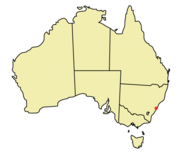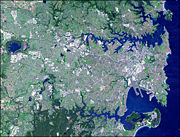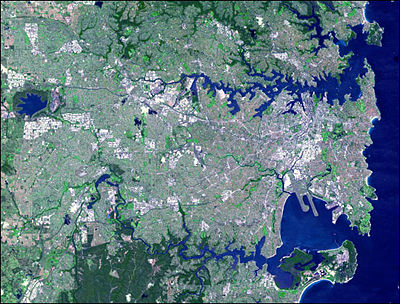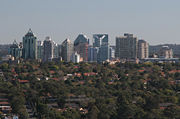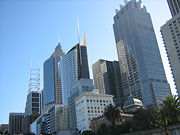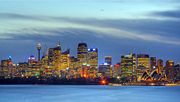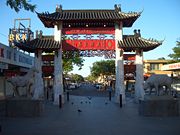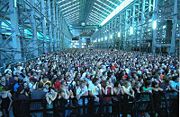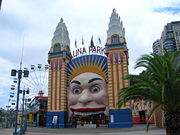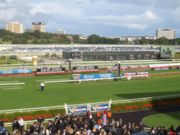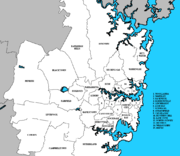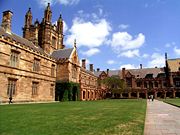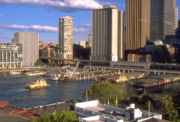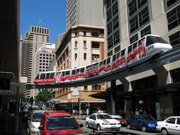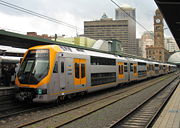Sydney
2008/9 Schools Wikipedia Selection. Related subjects: Cities; Oceania (Australasia)
| Sydney New South Wales |
|||||||
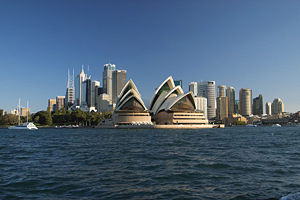 The Sydney Opera House and Sydney CBD on Port Jackson |
|||||||
| Population: | 4,284,379 ( 1st) | ||||||
| • Density: | 2058/km² (5330.2/sq mi) (2006) | ||||||
| Established: | 26 January 1788 | ||||||
| Coordinates: | Coordinates: | ||||||
| Area: | 12144.6 km² (4689.1 sq mi) | ||||||
| Time zone: • Summer ( DST) |
AEST ( UTC+10) AEDT ( UTC+11) |
||||||
| Location: | |||||||
| LGA: | various (38) | ||||||
| County: | Cumberland | ||||||
| State District: | various (49) | ||||||
| Federal Division: | various (22) | ||||||
|
|||||||
Sydney (pronounced /ˈsɪdniː/) is the most populous city in Australia, with a metropolitan area population of approximately 4.28 million (2006 estimate). It is the state capital of New South Wales, and the site of the first British colony in Australia, established in 1788 at Sydney Cove by Arthur Phillip, leader of the First Fleet from Britain. A resident of the city is referred to as a Sydneysider.
Sydney is located on Australia's south-east coast. The city is built around Port Jackson, which includes Sydney Harbour, leading to the city's nickname, "the Harbour City". It is noted for the Sydney Opera House and the Harbour Bridge, and its beaches. The metropolitan area is surrounded by national parks, and contains many bays, rivers and inlets. It is listed as a beta world city by the Loughborough University group's 1999 inventory. The city has hosted international sporting, political and cultural events, including the 1938 British Empire Games, 2000 Summer Olympics and the 2003 Rugby World Cup. In September 2007, the city hosted the leaders of the 21 APEC economies for APEC Australia 2007, and in July 2008 will host World Youth Day 2008. The main airport serving Sydney is Sydney Airport.
Sydney is one of the most multicultural cities in the world, which reflects its role as a major destination for immigrants to Australia. According to the Mercer cost of living survey, Sydney is Australia’s most expensive city, and the 21st most expensive in the world.
History
Radiocarbon dating suggests that the Sydney region has been inhabited by indigenous Australians for at least 30,000 years. At the time of the arrival of the First Fleet in 1788, 4000 - 8000 Aboriginal people lived in the region. The British called them " Eora", because being asked where they came from, these people would answer: "Eora", meaning in their language: "here", or "from this place". There were three language groups in the Sydney region, which were divided into dialects spoken by smaller clans. The principal languages were Darug (the Cadigal, original inhabitants of the City of Sydney, spoke a coastal dialect of Darug), Dharawal and Guringai. Each clan had a territory; the location of that territory determined the resources available. Although urbanization has destroyed most evidence of these settlements (such as shell middens), Sydney and its environs have rock drawings and carvings because of the nature of the rock, Hawkesbury sandstone.
In 1770, British sea captain Lieutenant James Cook landed in Botany Bay. Under instruction from the British government, a convict settlement was founded by Arthur Phillip, who arrived at Botany Bay with a fleet of 11 ships on January 20, 1788. This site was soon found to be unsuitable for habitation, owing to poor soil and a lack of reliable fresh water. Phillip founded the colony, further up the coast, at Sydney Cove on Port Jackson on 26 January 1788. He named it after the British Home Secretary, Thomas Townshend, Lord Sydney, in recognition of Sydney's role in issuing the charter authorising Phillip to establish a colony. In April 1789 a disease, thought to be smallpox, killed an estimated 500 to 1000 Aboriginal people between Broken Bay and Botany Bays. There was violent resistance to British settlement, notably by the warrior Pemulwuy in the area around Botany Bay, and conflicts were common in the area surrounding the Hawkesbury River. By 1820 there were only a few hundred Aborigines and Governor Macquarie had begun initiatives to 'civilize, Christianize and educate' the Aborigines by removing them from their clans.
Macquarie's tenure as Governor of New South Wales was a period when Sydney was improved from its basic beginnings. Roads, bridges, wharves and public buildings were constructed by British and Irish convicts, and by 1822 the town had banks, markets, well-established thoroughfares and an organised constabulary. The 1830s and 1840s were periods of urban development, including the development of the first suburbs, as the town grew rapidly when ships began arriving from Britain and Ireland with immigrants looking to start a new life in a new country. On 20 July 1842 the municipal council of Sydney was incorporated and the town was declared the first city in Australia, with Charles H. Chambers the first mayor. The first of several gold rushes started in 1851, and the port of Sydney has since seen many waves of people arriving from around the world. Rapid suburban development began in the last quarter of the 19th century with the advent of steam powered tramways and railways. With industrialisation Sydney expanded rapidly, and by the early 20th century it had a population well in excess of one million. The Great Depression hit Sydney badly. One of the highlights of the Depression era, however, was the completion of the Sydney Harbour Bridge in 1932.
A rivalry has traditionally existed between Sydney and Melbourne since the gold rushes of the 1850s grew the capital of Victoria into Australia's largest and richest city. Sydney overtook Melbourne in population in the early years of the 20th century, and has remained the largest city in Australia since this time. During the 1970s and 1980s Sydney's CBD with the Reserve Bank and Australian Stock Exchange clearly surpassed Melbourne as the nation's financial capital. Throughout the 20th century, especially in the decades immediately following World War II, Sydney continued to expand as large numbers of European and later Asian immigrants populated the metropolitan area. The culture brought about by immigrants was a major factor in the city's diverse and highly cosmopolitan atmosphere.
Geography
Topography
Sydney is in a coastal basin bordered by the Pacific Ocean to the east, the Blue Mountains to the west, the Hawkesbury River to the north and the Royal National Park to the south. Sydney lies on a submergent coastline, where the ocean level has risen to flood deep river valleys ( ria) carved in the hawkesbury sandstone. One of these drowned valleys, Port Jackson, better known as Sydney Harbour, is the largest natural harbour in the world. There are more than 70 harbour and ocean beaches, including the famous Bondi Beach, in the urban area. Sydney's urban area covers 1,687 km² (651 sq mi) as at 2001. The Sydney Statistical Division, used for census data, is the unofficial metropolitan area and covers 12,145 km² (4,689 sq mi). This area includes the Central Coast and Blue Mountains as well as broad swathes of national park and other unurbanised land.
Geographically, Sydney sprawls over two major regions: the Cumberland Plain, a relatively flat region lying to the south and west of the harbour, and the Hornsby Plateau, a sandstone plateau lying mainly to the north of the harbour, dissected by steep valleys. The oldest parts of the city are located in the flat areas south of the harbour; the North Shore was slower to develop because of its hilly topography, and was mostly a quiet backwater until the Sydney Harbour Bridge was opened in 1932, linking it to the rest of the city.
Climate
Sydney has a temperate climate with warm summers and mild winters, with rainfall spread throughout the year. The weather is moderated by proximity to the ocean, and more extreme temperatures are recorded in the inland western suburbs. The warmest month is January, with an average air temperature range at Observatory Hill of 18.6-25.8 °C (65.5-78.4 °F) and an average of 14.6 days a year over 30 °C (86.0 °F). The maximum recorded temperature was 45.3 °C (113.5 °F) on 14 January 1939 at the end of a 4 day nationwide heat wave. The winter is mildly cool, with temperatures rarely dropping below 5 °C (41 °F) in coastal areas. The coldest month is July, with an average range of 8-16.2 °C (46.4-61.2 °F). The lowest recorded minimum was 2.1 °C (35.8 °F). Rainfall is fairly evenly divided between summer and winter, but is slightly higher during the first half of the year, when easterly winds dominate. The average annual rainfall, with moderate to low variability, is 1,217 mm (48 in), falling on an average 138 days a year. Snowfall last occurred in the Sydney City area in the 1830s.
| Climate chart for Sydney | |||||||||||
|---|---|---|---|---|---|---|---|---|---|---|---|
| J | F | M | A | M | J | J | A | S | O | N | D |
|
103
26
19
|
117
26
19
|
131
25
18
|
127
22
15
|
123
19
12
|
128
17
9
|
98
16
8
|
82
18
9
|
69
20
11
|
77
22
14
|
83
24
16
|
78
25
18
|
| temperatures in °C precipitation totals in mm |
|||||||||||
|
Imperial conversion
|
|||||||||||
Although the city does not suffer from cyclones or significant earthquakes, the El Niño Southern Oscillation plays an important role in determining Sydney's weather patterns: drought and bushfire on the one hand, and storms and flooding on the other, associated with the opposite phases of the oscillation. Many areas of the city bordering bushland have experienced bushfires, notably in 1994 and 2001-02 — these tend to occur during the spring and summer. The city is also prone to severe hail storms and wind storms. One such storm was the 1999 hailstorm, which severely damaged Sydney's eastern and city suburbs. The storm produced massive hailstones of at least 9 cm (3.5 in) in diameter and resulting in insurance losses of around AUD $1.7 billion in less than five hours. The city is also prone to flash flooding from enormous amounts of rain caused by East Coast Lows (a low pressure depression which deepens off the state usually in winter and early spring which can bring significant damage by heavy rain, cyclonic winds and huge swells). The most notable event was the great Sydney flood which occurred on 6 August 1986 and dumped a record 327.6 mm (12.9 in) on the city in 24 hours. This caused major traffic chaos and damage in many parts of the metropolitan area.
The Bureau of Meteorology has reported that 2002 through 2005 were the warmest summers in Sydney since records began in 1859. 2004 had an average daily maximum temperature of 23.39 °C, 2005 - 23.35 °C, 2002 - 22.91 °C and 2003 - 22.65 °C. The average daily maximum between 1859 and 2004 was 21.6 °C (70.9 °F). For the first nine months of 2006 the mean temperature was 18.41 °C (65.1 °F); the warmest year previously was 2004 with 18.51 °C (65.32 °F). Since November 2003, there have been only two months in which the average daily maximum was below average: March 2005 (about 1 °C below average) and June 2006 (0.7 °C below average).
However, the summer of 2007-08 proved to be one of the coolest on record. The Bureau of Meteorology reported that it was the coolest summer in 11 years, the wettest summer in six years, and one of only three summers in recorded history to lack a maximum temperature above 31 °C (88 °F).
| Jan | Feb | Mar | Apr | May | Jun | Jul | Aug | Sep | Oct | Nov | Dec | Year | ||
|---|---|---|---|---|---|---|---|---|---|---|---|---|---|---|
| Mean daily maximum temperature ( °C) | 25.8 | 25.7 | 24.7 | 22.4 | 19.3 | 16.9 | 16.2 | 17.7 | 19.9 | 22.0 | 23.6 | 25.1 | 21.6 | |
| Mean daily minimum temperature (°C) | 18.6 | 18.7 | 17.5 | 14.7 | 11.5 | 9.2 | 8.0 | 8.9 | 11.0 | 13.5 | 15.5 | 17.5 | 13.7 | |
| Mean total rainfall ( mm) | 103.3 | 117.4 | 131.2 | 127.2 | 123.3 | 128.1 | 98.1 | 81.5 | 68.7 | 76.9 | 83.1 | 78.1 | 1217.0 | |
| Mean number of rain days | 12.1 | 12.3 | 13.3 | 12.0 | 12.0 | 11.4 | 10.3 | 9.9 | 10.3 | 11.5 | 11.4 | 11.5 | 138.0 | |
| Source: Bureau of Meteorology | ||||||||||||||
Urban structure
Sydney's central business district (CBD) extends southwards for about 3 kilometres (1.25 mi) from Sydney Cove, the point of the first European settlement in the area at the southern end of the bridge known as " The Rocks". Densely concentrated skyscrapers and other buildings including historic sandstone buildings such as the Sydney Town Hall and Queen Victoria Building are interspersed by several parks such as Wynyard and Hyde Park. The Sydney CBD is bounded on the east side by a chain of parkland that extends from Hyde Park through the Domain and Royal Botanic Gardens to Farm Cove on the harbour. The west side is bounded by Darling Harbour, a popular tourist and nightlife precinct while Central station marks the southern end of the CBD. George Street serves as the Sydney CBD's main north-south thoroughfare.
As the site of earliest European settlement in Australia, the CBD contains many other historic buildings such as the Sydney Mint, one of Australia's oldest buildings, Fort Denison, a penal site which was built in the colonial days on a small island situated on the harbour, as well as heritage listed buildings in The Rocks. The area also boasts well known modern architectural sites such as the Sydney Opera House and Martin Place.
Although the CBD dominated the city's business and cultural life in the early days, other business/cultural districts have developed in a radial pattern since World War II. As a result, the proportion of white-collar jobs located in the CBD declined from more than 60 per cent at the end of World War II to less than 30 per cent in 2004. Together with the commercial district of North Sydney, joined to the CBD by the Harbour Bridge, the most significant outer business districts are Parramatta in the central-west, Penrith in the west, Bondi Junction in the east, Liverpool in the southwest, Chatswood to the north, and Hurstville to the south.
The extensive area covered by urban Sydney is formally divided into more than 300 suburbs (for addressing and postal purposes), and administered as 38 local government areas. There is no city-wide government, but the Government of New South Wales and its agencies have extensive responsibilities in providing metropolitan services. The City of Sydney itself covers a fairly small area comprising the central business district and its neighbouring inner-city suburbs. In addition, regional descriptions are used informally to conveniently describe larger sections of the urban area. These include Eastern Suburbs, Hills District, Inner West, Canterbury-Bankstown, Lower North Shore, Northern Beaches, Northern Suburbs, North Shore, St George, Southern Sydney, South-eastern Sydney, South-western Sydney, Sutherland Shire and Western Sydney. However, many suburbs are not conveniently covered by any of these categories.
Economy
Sydney is a modern, prosperous city with the highest median household income of any major city in Australia ( US$42,559 PPP).
The largest economic sectors in Sydney, measured by numbers of people employed, include property and business services, retail, manufacturing, and health and community services. Since the 1980s, jobs have moved from manufacturing to the services and information sectors. Sydney provides approximately 25 percent of the country's total GDP.
Sydney is the largest corporate and financial centre in Australia and is also an important financial centre in the Asia Pacific. The Australian Securities Exchange and the Reserve Bank of Australia are located in Sydney, as are the headquarters of 90 banks and more than half of Australia's top companies, and the regional headquarters for around 500 multinational corporations. Of the ten largest corporations in Australia (based on revenue), four have headquarters in Sydney ( Caltex Australia, the Commonwealth Bank, Westpac, and Woolworths). Fox Studios Australia has large movie studios in the city.
The Sydney Futures Exchange (SFE) is one of the Asia Pacific's largest financial futures and options exchanges, with 64.3 million contracts traded during 2005. In global terms it is the 12th largest futures market in the world and the 19th largest including options.
Tourism plays an important role in Sydney's economy, with 7.8 million domestic visitors and 2.5 million international visitors in 2004.
Sydney's retail environment is flourishing, with many shopping centres and retail outlets throughout the city. Premier locations in the central city include the Queen Victoria Building on George Street, the pedestrian mall on Pitt Street and the quieter, northern end of Castlereagh St. Along the latter are most of the international luxury boutiques in Sydney such as Jimmy Choo, Versace, Gucci and Chanel. Oxford Street in Paddington and Crown Street, Woollahra are home to boutiques selling more niche products while the main streets of Newtown and Enmore cater more towards students and alternative lifestyles. Many of the large regional centres around the metropolitan area also contain large shopping complexes, such as Parramatta in Western Sydney, Bondi Junction in the Eastern Suburbs and Chatswood on the North Shore, most of which are Westfield brand shopping centres.
As of 2004, the unemployment rate in Sydney was 4.9 percent. According to The Economist Intelligence Unit's Worldwide cost of living survey, Sydney is the sixteenth most expensive city in the world, while a UBS survey ranks Sydney as 18th in the world in terms of net earnings.
As of 20 September 2007, Sydney has the highest median house price of any Australian capital city at $559 000. Sydney also has the highest median rent prices of any Australian city at $450 a week. A report published by the OECD in November 2005, shows that Australia has the Western World's highest housing prices when measured against rental yields.
Sydney has been classified as a "Beta" global city by the Globalization and World Cities Study Group and Network.
Demographics
| Significant overseas born populations | |
| Country of Birth | Population (2006) |
|---|---|
| United Kingdom | 175,165 |
| Mainland China | 109,143 |
| New Zealand | 81,064 |
| Vietnam | 62,144 |
| Lebanon | 54,501 |
| India | 52,974 |
| Philippines | 52,087 |
| Italy | 44,562 |
| Hong Kong | 36,867 |
| South Korea | 32,125 |
| Greece | 32,021 |
| South Africa | 28,429 |
| Fiji | 26,929 |
| Malaysia | 21,213 |
| Indonesia | 20,560 |
| Iraq | 20,217 |
At the time of the 2006 census, there were 4,119,190 residents present in the Sydney Statistical Division. Of those 3,641,422 lived in Sydney's urban area. Inner Sydney was the most densely populated place in Australia with 4,023 persons per square kilometre. The statistical division is larger in area than the urban area, as it allows for predicted growth. A resident of Sydney is commonly referred to as a Sydneysider.
In the 2006 census, the most common self-described ancestries identified for Sydney residents were Australian, English, Irish, Scottish and Chinese. The Census also recorded that one per cent of Sydney's population identified as being of indigenous origin and 39.4 per cent were born overseas. The three major sources of immigrants are the United Kingdom, China and New Zealand. Significant numbers of immigrants also came from Vietnam, Lebanon, Italy, India and the Philippines. Most Sydneysiders are native speakers of English; many have a second language, the most common being Arabic (predominately Lebanese), Chinese languages (mostly Mandarin or Cantonese), and Italian. Sydney has the seventh largest percentage of a foreign born population in the world, ahead of cities such as the highly multicultural London and Paris.
The median age of a Sydney resident is 34, with 12 per cent of the population over 65 years. 15.2 per cent of Sydney residents have educational attainment equal to at least a bachelor's degree, which is lower than the national average of 19 per cent.
According to the 2006 census, 64 per cent of the Sydney residents are identified as Christians, 3.7 per cent as Buddhists, 3.9 per cent as Muslims, 1.7 per cent as Hindus, 0.9 per cent as Jews and 14.1 per cent as having no religion.
Ancestry
According to the Australian Bureau of Statistics:
- 24% Australian (mostly British people: English people, Irish people, Welsh people, Scottish people, Cornish people and Manx people)
- 20% English
- 6.3% Irish
- 5.7% Chinese
- 4.8% Scottish
- 3.7% Arab (Lebanese, Syrian, Iraqi, Arab nfd, Egyptian, Jordanian, Mauritanian, Palestinian, Sudanese, Arab nec, and others)
- 3.4% Italian
- 2.1% Greek
- 2% German
- 20.6% others (does not go into the hundreds of thousands)
- 7.4% not stated
Culture
Sydney hosts many different festivals and some of Australia's largest social and cultural events. These include the Sydney Festival, Australia's largest arts festival which is a celebration involving both indoor and free outdoor performances throughout January; the Biennale of Sydney, established in 1973; the Big Day Out, a travelling rock music festival which originated in Sydney; the Gay and Lesbian Mardi Gras along Oxford Street; the Sydney Film Festival and many other smaller film festivals such as the short film Tropfest and Flickerfest. Australia's premier prize for portraiture, the Archibald Prize is organised by the Art Gallery of New South Wales. The Sydney Royal Easter Show is held every year at Sydney Olympic Park, the final of Australian Idol takes place on the steps of the Opera House, and Australian Fashion Week takes place in April/May. Also, Sydney's New Years Eve and Australia Day celebrations are the largest in Australia.
Entertainment and performing arts
Sydney has a wide variety of cultural institutions. Sydney's iconic Opera House has five theatres capable of hosting a range of performance styles; it is the home of Opera Australia—the third busiest opera company in the world, and the Sydney Symphony Orchestra. Other venues include the Sydney Town Hall, City Recital Hall, the State Theatre and the Wharf Theatre.
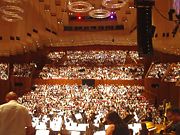
The Sydney Dance Company under the leadership of Graeme Murphy during the late 20th century has also gained acclaim. The Sydney Theatre Company has a regular roster of local plays, such as noted playwright David Williamson, classics and international playwrights.

In 2007, New Theatre (Newtown) celebrated 75 years of continuous production in Sydney. Other important theatre companies in Sydney include Company B and Griffin Theatre Company. From the 1940s through to the 1970s the Sydney Push, a group of authors and political activists whose members included Germaine Greer, influenced the city's cultural life.
The National Institute of Dramatic Art, based in Kensington, boasts internationally famous alumni such as Mel Gibson, Judy Davis, Baz Luhrmann and Cate Blanchett. Sydney's role in the film industry has increased since the opening of Fox Studios Australia in 1998. Prominent films which have been filmed in the city include Moulin Rouge!, Mission Impossible II, Star Wars episodes II and III, Superman Returns, Dark City, Dil Chahta Hai, Happy Feet and The Matrix. Films using Sydney as a setting include Finding Nemo, Strictly Ballroom, Mission Impossible II, Muriel's Wedding, and Dirty Deeds. As of 2006, over 229 films have been set in, or featured Sydney.
Sydney's most popular nightspots include Kings Cross, Oxford Street, Darling Harbour, Circular Quay and The Rocks which all contain various bars, nightclubs and restaurants. Star City Casino, is Sydney's only casino and is situated around Darling Harbour. There are also many traditional pubs, cafes and restaurants in inner city areas such as Newtown, Balmain and Leichhardt. Sydney's main live music hubs include areas such as Newtown and Annandale. It once had a thriving live music scene in the 1970s and 1980s, nurturing acts such as AC/DC, Midnight Oil and INXS. Other popular nightspots tend to be spread throughout the city in areas such as Bondi, Manly and Parramatta.
Tourism
Sydney has several popular museums. The biggest are the Australian Museum (natural history and anthropology), the Powerhouse Museum (science, technology and design), the Art Gallery of New South Wales, the Museum of Contemporary Art and the Australian National Maritime Museum.
Sport and outdoor activities
Sport in Sydney is an important part of the culture. The area is well endowed with open spaces and access to waterways, and has many natural areas even within the city centre. Within the Sydney central business district are the Chinese Garden of Friendship, Hyde Park, The Domain and the Royal Botanical Gardens. The metropolitan area contains several national parks, including the Royal National Park, the second oldest national park in the world and several parks in Sydney's far west which are part of the World Heritage listed Greater Blue Mountains Area.
One of the most popular sports in Sydney is Rugby League. The sport was brought from England to Sydney before expanding to the rest of Australia. The city is home to nine of the sixteen teams in the National Rugby League domestic competition. These are Canterbury Bulldogs, Cronulla Sharks, Manly Sea Eagles, Penrith Panthers, Parramatta Eels, South Sydney Rabbitohs, St George Illawarra Dragons, Sydney Roosters and Wests Tigers. Despite the final of the 2008 Rugby League World Cup being held in Brisbane, Sydney will host eight World Cup games including one of the Semi-Finals.
Sydney is home to the Australian Football League's Sydney Swans and the A-League's Sydney FC. The city is represented by two teams in the National Basketball League, netball's Sydney Swifts and is the base for New South Wales teams in the Super 14 ( NSW Waratahs) and Pura Cup ( Blues) competitions. Large sporting events, such as the NRL Grand Final, are regularly held at the ANZ Stadium, the main stadium for the 2000 Summer Olympics. Other events in Sydney include the start of the Sydney to Hobart Yacht Race and the City to Surf foot race.
Governance
Apart from the limited role of the Cumberland County Council from 1945–1964, there has never been an overall governing body for the Sydney metropolitan area; instead, the metropolitan area is divided into local government areas (LGAs). These areas have elected councils which are responsible for functions delegated to them by the New South Wales State Government, such as planning and garbage collection.
The City of Sydney includes the central business area and some adjoining inner suburbs, and has in recent years been expanded through amalgamation with adjoining local government areas, such as South Sydney. It is led by the elected Lord Mayor of Sydney and a council. The Lord Mayor, however, is sometimes treated as a representative of the whole city, for example during the Olympics.
Most citywide government activities are controlled by the state government. These include public transport, main roads, traffic control, policing, education above preschool level, and planning of major infrastructure projects. Because a large proportion of New South Wales' population lives in Sydney, state governments have traditionally been reluctant to allow the development of citywide governmental bodies, which would tend to rival the state government. For this reason, Sydney has always been a focus for the politics of both State and Federal Parliaments. For example, the boundaries of the City of Sydney LGA have been significantly altered by state governments on at least four occasions since 1945, with expected advantageous effect to the governing party in the New South Wales Parliament at the time.
The 38 LGAs commonly described as making up Sydney are:
|
|
|
|
|
|
Different organisations have varying definitions of which councils make up Sydney. The Local Government Association of New South Wales considers all LGAs lying entirely in Cumberland County as part of its 'Metro' group, which excludes Camden (classed in its 'Country' group). The Australian Bureau of Statistics defines a Sydney Statistical Division (the population figures of which are used in this article) that includes all of the above councils as well as Wollondilly, the Blue Mountains, Hawkesbury, Gosford and Wyong.
Education
Sydney is home to some of Australia's most prominent universities, and is the site of Australia's first university, the University of Sydney, established in 1850. There are five other public universities operating primarily in Sydney: the University of New South Wales, Macquarie University, the University of Technology, Sydney, the University of Western Sydney, and the Australian Catholic University (two out of six campuses). Other universities which operate secondary campuses in Sydney include the University of Notre Dame Australia and the University of Wollongong.
There are four multi-campus government-funded Technical and Further Education (TAFE) institutes in Sydney, which provide vocational training at a tertiary level: the Sydney Institute of Technology, Northern Sydney Institute of TAFE, Western Sydney Institute of TAFE and South Western Sydney Institute of TAFE.
Sydney has public, denominational and independent schools. Public schools, including pre-schools, primary and secondary schools, and special schools are administered by the New South Wales Department of Education and Training. There are four state-administered education areas in Sydney, that together co-ordinate 919 schools. Of the 30 selective high schools in the state, 25 are in Sydney.
Infrastructure
Health systems
The Government of New South Wales operates the public hospitals in the Sydney metropolitan region. Management of these hospitals and other specialist health facilities is coordinated by 4 Area Health Services: Sydney South West (SSWAHS), Sydney West (SWAHS), Northern Sydney and Central Coast (NSCCAHS) and the South Eastern Sydney and Illawarra (SESIAHS) Area Health Services. There are also a number of private hospitals in the city, many of which are aligned with religious organisations.
Transport
Most Sydney residents travel by car through the system of roads, and motorways. The most important trunk routes in the urban area form the nine Metroad systems, which includes the 110 km (68 mi) Sydney Orbital Network. Sydney is also served by extensive train, taxi, bus and ferry networks.
Sydney trains are run by CityRail, a corporation of the New South Wales State Government. Trains run as suburban commuter rail services in the outer suburbs, then converge in an underground city loop service in the central business district. In the years following the 2000 Olympics, CityRail's performance declined significantly. In 2005, CityRail introduced a revised timetable and employed more drivers. A large infrastructure project, the Clearways project, is scheduled to be completed by 2010. In 2007 a report found Cityrail performed poorly compared to many metro services from other world cities. Sydney has one privately operated light rail line, the Metro Light Rail, running from Central Station to Lilyfield along a former goods train line. There is also a small monorail which runs in a loop around the main shopping district and Darling Harbour. Sydney was once served by an extensive tram network, which was progressively closed in the 1950s and 1960s. Most parts of the metropolitan area are served by buses, many of which follow the pre-1961 tram routes. In the city and inner suburbs the state-owned Sydney Buses has a monopoly. In the outer suburbs, service is contracted to many private bus companies. Construction of a network of rapid bus transitways in areas not previously well served by public transport began in 1999, and the first of these, the Liverpool-Parramatta Rapid Bus Transitway opened in February 2003. Sydney Ferries, another State government-owned organisation, runs numerous commuter and tourist ferry services on Sydney Harbour and the Parramatta River.
Sydney Airport, located in the suburb of Mascot, is Sydney's main airport, and is one of the oldest continually operated airports in the world . The smaller Bankstown Airport mainly serves private and general aviation. There are light aviation airfields at Hoxton Park and Camden. RAAF Base Richmond lies to the north-west of the city. The question of whether Sydney needs a second airport has raised much controversy. A 2003 study found that Kingsford Smith can manage as Sydney's sole international airport for 20 years with a significant increase in airport traffic predicted. The resulting expansion of the airport would have a substantial impact on the community, including additional aircraft noise affecting residents. Land has been acquired at Badgerys Creek for a second airport, the site acting as a focal point of political argument.
Utilities
Water storage and supply for Sydney is managed by the Sydney Catchment Authority, which is an agency of the NSW Government that sells bulk water to Sydney Water and other agencies. Water in the Sydney catchment is chiefly stored in dams in the Upper Nepean Scheme, the Blue Mountains, Woronora Dam, Warragamba Dam and the Shoalhaven Scheme. Historically low water levels in the catchment have led to water use restrictions and the NSW government is investigating alternative water supply options, including grey water recycling and the construction of a seawater reverse osmosis desalination plant at Kurnell. Sydney Water also collects the wastewater and sewage produced by the city.
Three companies supply natural gas and electricity to Sydney: Energy Australia, AGL and Integral Energy. Numerous telecommunications companies operate in Sydney providing terrestrial and mobile telecommunications services.


